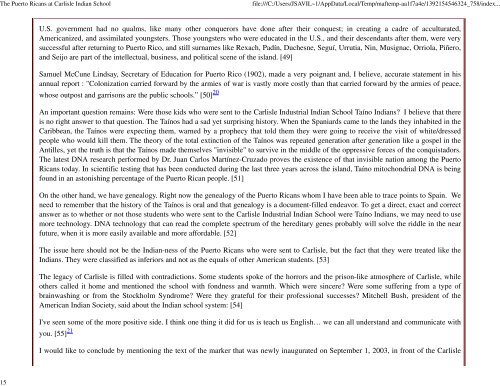The Puerto Ricans at Carlisle Indian School
by Sonia M. Rosa
by Sonia M. Rosa
You also want an ePaper? Increase the reach of your titles
YUMPU automatically turns print PDFs into web optimized ePapers that Google loves.
15<br />
he <strong>Puerto</strong> <strong>Ricans</strong> <strong>at</strong> <strong>Carlisle</strong> <strong>Indian</strong> <strong>School</strong><br />
file:///C:/Users/JSAVIL~1/AppD<strong>at</strong>a/Local/Temp/maftemp-aa1f7a4e/1392154546324_758/index...<br />
U.S. government had no qualms, like many other conquerors have done after their conquest; in cre<strong>at</strong>ing a cadre of accultur<strong>at</strong>ed,<br />
Americanized, and assimil<strong>at</strong>ed youngsters. Those youngsters who were educ<strong>at</strong>ed in the U.S., and their descendants after them, were very<br />
successful after returning to <strong>Puerto</strong> Rico, and still surnames like Rexach, Padín, Duchesne, Seguí, Urrutia, Nin, Musignac, Orriola, Piñero,<br />
and Seijo are part of the intellectual, business, and political scene of the island. [49]<br />
Samuel McCune Lindsay, Secretary of Educ<strong>at</strong>ion for <strong>Puerto</strong> Rico (1902), made a very poignant and, I believe, accur<strong>at</strong>e st<strong>at</strong>ement in his<br />
annual report : "Coloniz<strong>at</strong>ion carried forward by the armies of war is vastly more costly than th<strong>at</strong> carried forward by the armies of peace,<br />
whose outpost and garrisons are the public schools.” [50] 20<br />
An important question remains: Were those kids who were sent to the <strong>Carlisle</strong> Industrial <strong>Indian</strong> <strong>School</strong> Taíno <strong>Indian</strong>s? I believe th<strong>at</strong> there<br />
is no right answer to th<strong>at</strong> question. <strong>The</strong> Taínos had a sad yet surprising history. When the Spaniards came to the lands they inhabited in the<br />
Caribbean, the Taínos were expecting them, warned by a prophecy th<strong>at</strong> told them they were going to receive the visit of white/dressed<br />
people who would kill them. <strong>The</strong> theory of the total extinction of the Taínos was repe<strong>at</strong>ed gener<strong>at</strong>ion after gener<strong>at</strong>ion like a gospel in the<br />
Antilles, yet the truth is th<strong>at</strong> the Taínos made themselves "invisible" to survive in the middle of the oppressive forces of the conquistadors.<br />
<strong>The</strong> l<strong>at</strong>est DNA research performed by Dr. Juan Carlos Martínez-Cruzado proves the existence of th<strong>at</strong> invisible n<strong>at</strong>ion among the <strong>Puerto</strong><br />
<strong>Ricans</strong> today. In scientific testing th<strong>at</strong> has been conducted during the last three years across the island, Taíno mitochondrial DNA is being<br />
found in an astonishing percentage of the <strong>Puerto</strong> Rican people. [51]<br />
On the other hand, we have genealogy. Right now the genealogy of the <strong>Puerto</strong> <strong>Ricans</strong> whom I have been able to trace points to Spain. We<br />
need to remember th<strong>at</strong> the history of the Taínos is oral and th<strong>at</strong> genealogy is a document-filled endeavor. To get a direct, exact and correct<br />
answer as to whether or not those students who were sent to the <strong>Carlisle</strong> Industrial <strong>Indian</strong> <strong>School</strong> were Taíno <strong>Indian</strong>s, we may need to use<br />
more technology. DNA technology th<strong>at</strong> can read the complete spectrum of the hereditary genes probably will solve the riddle in the near<br />
future, when it is more easily available and more affordable. [52]<br />
<strong>The</strong> issue here should not be the <strong>Indian</strong>-ness of the <strong>Puerto</strong> <strong>Ricans</strong> who were sent to <strong>Carlisle</strong>, but the fact th<strong>at</strong> they were tre<strong>at</strong>ed like the<br />
<strong>Indian</strong>s. <strong>The</strong>y were classified as inferiors and not as the equals of other American students. [53]<br />
<strong>The</strong> legacy of <strong>Carlisle</strong> is filled with contradictions. Some students spoke of the horrors and the prison-like <strong>at</strong>mosphere of <strong>Carlisle</strong>, while<br />
others called it home and mentioned the school with fondness and warmth. Which were sincere? Were some suffering from a type of<br />
brainwashing or from the Stockholm Syndrome? Were they gr<strong>at</strong>eful for their professional successes? Mitchell Bush, president of the<br />
American <strong>Indian</strong> Society, said about the <strong>Indian</strong> school system: [54]<br />
I've seen some of the more positive side. I think one thing it did for us is teach us English… we can all understand and communic<strong>at</strong>e with<br />
you. [55] 21<br />
I would like to conclude by mentioning the text of the marker th<strong>at</strong> was newly inaugur<strong>at</strong>ed on September 1, 2003, in front of the <strong>Carlisle</strong>

















